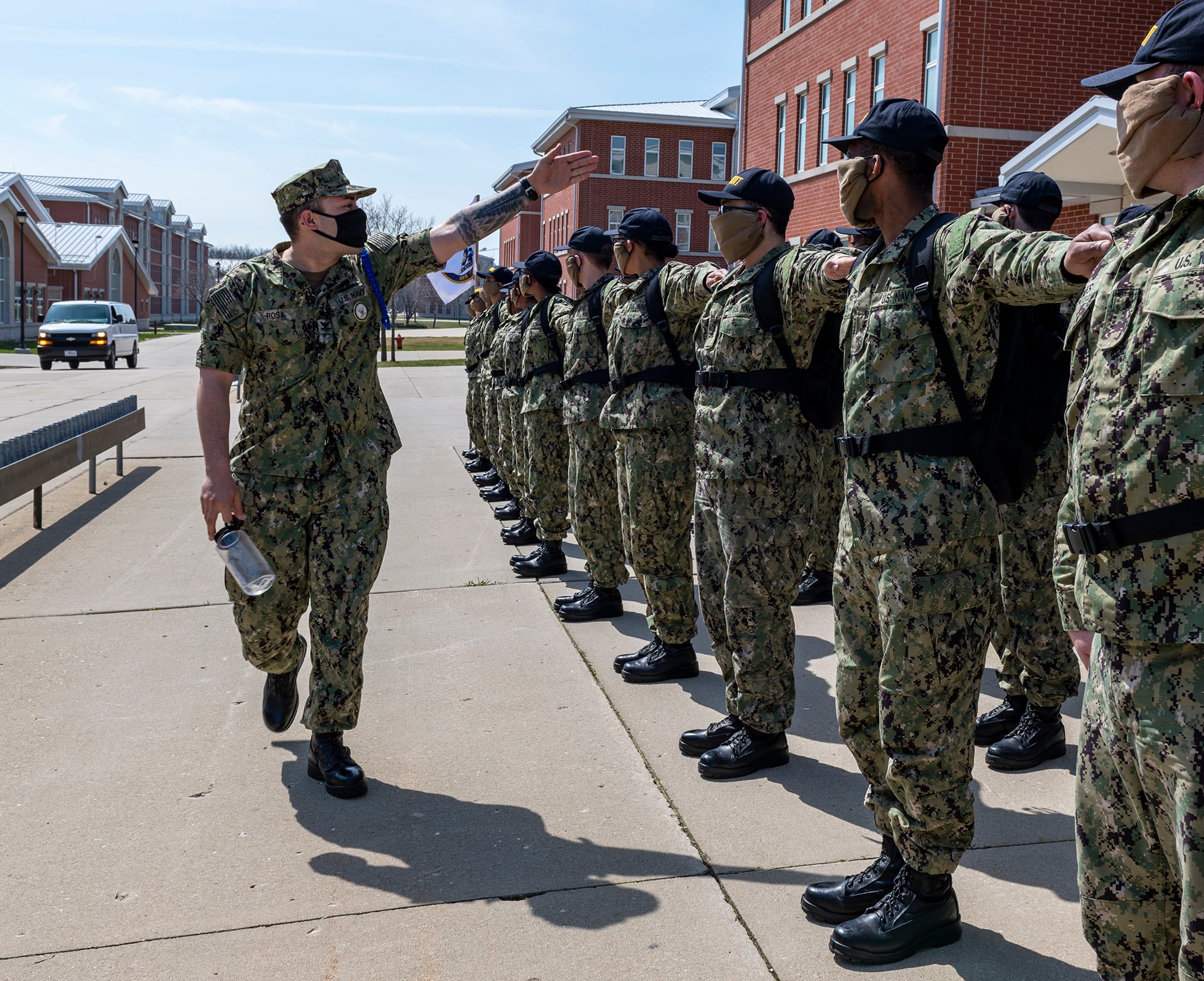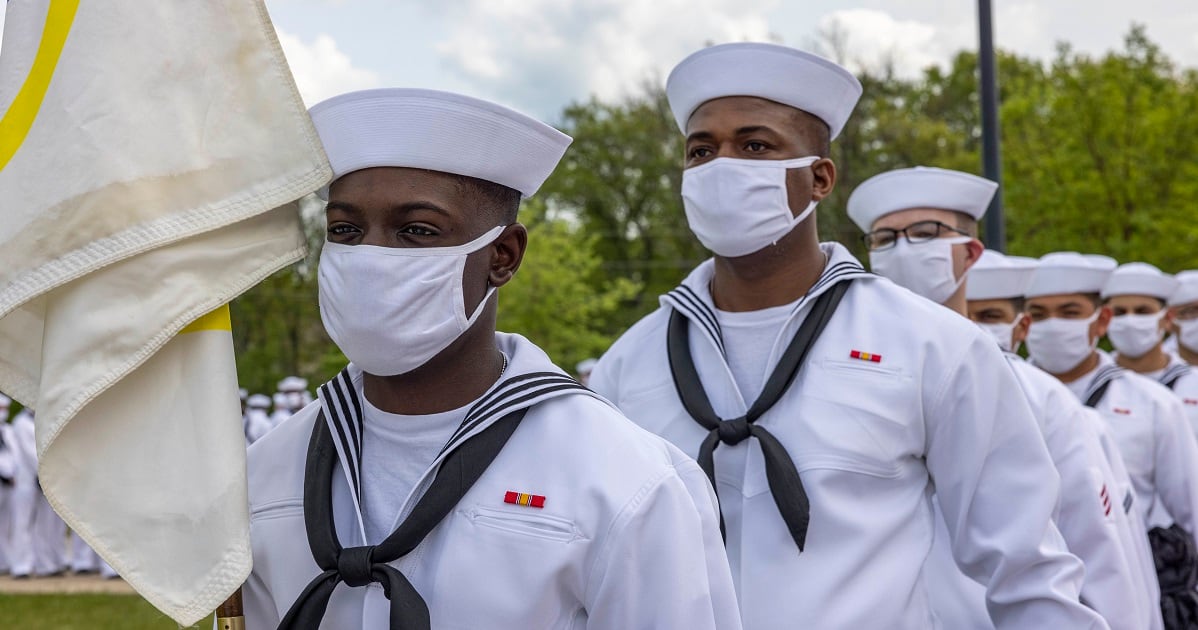The Navy is adding more mentorship, life skills and personal and professional development to its boot camp curriculum as it expands recruit training to 10 weeks — up from eight.
The revamped Basic Military Training at Recruit Training Command aboard Naval Station Great Lakes, Illinois, first reported by Navy Times in December, kicked off Jan. 3, and includes the new “Sailor for Life” module that aims to better prepare recruits for life after boot camp.
“Identity transformation in eight weeks is a lot to ask,” Fleet Master Chief Wes Koshoffer told reporters Friday. “We know that habit change, lifestyle change, developing toughness, resilience, forging character, are processes that take time … that two weeks really makes the difference.”
After completing the eight weeks of original boot camp, recruits become sailors and stay at Great Lakes for an additional two weeks to really hammer down what they learned at BMT and adjust from civilian to sailor life. The objective is to provide sailors with additional resources and fleet-centric training that will contribute to their success in the Navy.
“Our ships, submarines, aircraft and other fleet units have got a lot on their plate,” Rear Adm. Jennifer Couture, the commander of Naval Service Training Command, told reporters. “And they do not have the time to do basic training. That’s my job to do basic training.”
To that end, the life skills portion of the “Sailor for Life” module encompasses a broad range of topics including sexual harassment and assault prevention training, suicide prevention training and anti-hazing training, along with organizational skills, personal financial management and time management.
Sailors will also learn how to conduct a permanent change of station, or PSC move, and about shipboard living environment techniques and higher education opportunities.
RELATED

“We’re really taking some time to sit down with them and explain some basic onboarding procedures that we know that they need to have before they go off into life in the Navy,” Couture said.
The additional two weeks also incorporates advanced Warrior Toughness training, which was first introduced to recruits in 2018 and aims to teach sailors how to perform in stressful situations, based on concepts originally developed by Naval Special Warfare. The advanced training in the “Sailor for Life” module is tailored toward fostering a team mindset in settings that demand elite performance.
“That means that we are trying to give sailors some preventative maintenance, I’ll call it,” Couture said. “We’re leaning in and giving them some tools that they can use to prepare themselves as individuals to be part of a warfighting team.”
The expanded BMT aims to boost physical performance as well.

“We expect that the additional two weeks of basic training is also going to reap some benefits in terms of our physical performance as well,” Couture said. “We are incorporating some additional high performance, physical fitness regimes to also make sure that our sailors are tough to endure as well.”
The “Sailor for Life” module will also place emphasis on mentorship, which Couture said was inspired by the Marine Corps’ focus on mentorship in the final phase of their boot camp. That involves veering away from classroom-type settings, and working in more practical settings with their mentors.
“It’s reinforcing the things that they’ve learned in the first eight weeks, giving them more practical applications, more scenario-driven, more hands-on training,” Couture said.
The change is the result of feedback from the fleet amid great-power competition with Russia and China so that the U.S. Navy remains the best in the world, Koshoffer said. That sense of urgency has prompted the Navy to re-evaluate training, tactics, equipment and development of sailors, he said.
“The development of sailors is part and parcel, if not the single greatest advantage, that we have over other militaries of the world,” Koshoffer said.
Despite the increased time at Great Lakes, Navy leaders said the shift would not impact accessions or slow down getting sailors into the fleet. That means recruits will arrive at Great Lakes each week and graduations will continue on a weekly basis.
“We have not adjusted the quantity of sailors at all,” Couture said. “So they may be here a little bit longer, but they’re going to continue to graduate on pace.”
Koshoffer also noted that the throughput time won’t change significantly because some of the training added to BMT was originally being implemented elsewhere throughout the fleet. Now, it’s just being redistributed as part of BMT to help provide the fleet with sailors who are “basically trained upon arrival,” Couture said.
Instructors started getting qualified to teach the life skills section of the “Sailor for Life” module beginning in February 2021, according to Lt. Cmdr. Katy Bock, the military training director at RTC. She told reporters that the command collaborated with other units — like the MyNavy Coaching Team — to get instructors up to speed on the curriculum so they could teach it this year.
The training overhaul has been in the works for several years and is the first major overhaul of the Navy’s BMT in nearly 20 years, Couture said.
“Overall, our goals are to ensure that when the recruits graduate, these initiatives connect them to each other, they are engaged with being a part of the Navy, being a part of the organizational culture,” Couture said. “They’re tough, they’re resilient, and they can apply their tactics, techniques and procedures at the fleet level.”




